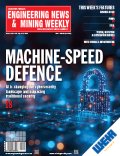Considerations for South Africa as it pursues single digital identity
With South Africa lagging behind in issuing identity documentation to all citizens, there are various economic and social gains that could be leveraged by using biometrics for identity validation.
The country could lean on the experiences of other countries that have successfully implemented this, but there are many considerations that must be acknowledged as this is pursued.
This was alluded to by speakers at an international seminar on the application of artificial intelligence (AI) in the design and execution of a single digital identity in South Africa.
The seminar, held in Johannesburg on May 31, was hosted by the National AI Institute, which is located within the Johannesburg Business School (JBS) at the University of Johannesburg (UJ).
The seminar is one of several catalytic projects of the recently launched National AI Institute, established in partnership with UJ, the Tshwane University of Technology and the Department of Communications and Digital Technologies.
It is estimated that 137-million people in Southern Africa do not possess identity documentation and, of that number, 15-million live in South Africa, according to research undertaken by The Economist in its ‘Digital Identity Report South Africa’ published in 2021.
This research is said to underpin the growing digital divide between the developed and developing world, and the need for a digital identity programme in South Africa, with the lack of legal identification posited to have considerable consequences for inclusive citizenship and the elimination of identity fraud.
In South Africa, challenges in pursuing a single digital identity, from a statistical point of view, include late registrations of births and deaths, besides others; people living in rural areas who are not registered; and foreign-born nationals who are not registered.
Therefore, there needs to be a system to incentivise people to be registered in the system.
In terms of benefits, from a statistical point of view, it was noted that using a digital identity could provide considerable cost savings for areas such as census counting.
Amazon Web Services (AWS) Middle East and Africa chief technologist Dr Shivagami Gugan outlined key considerations for South Africa as it looked to engender a single digital identity in the country.
This includes setting up an effective operational model; investing in building user trust; and building system interoperability and digital platform performance.
Moreover, government will need to get the top-down political will correct, as well as the judicial legal framework.
Gugan also pointed to the need to demonstrate value for users by building out high-value use cases.
She also encouraged engagement with the private sector at an early stage, as well as including them in the scaling-out process.
Gugan emphasised the need to build cross-border interoperability from the outset.
She also said design should be done with inclusion in mind – being cognisant of the economic, social and cultural barriers to adoption across user groups – and being creative in how these were addressed.
Gugan averred that, ideally, a single point of government leadership should be identified early to drive such a programme.
She also called on the country to learn from and make use of international bodies and standards.
Lastly, Gugan suggested that the country could use the momentum from Covid-19 to build on what had worked well in the digital space.
Gugan also mentioned 11 core principles for consideration, as outlined by the Digital Identity Working Group, which had eight member countries.
These are openness, transparency, usability, use centricity, inclusion and accessibility, multilingualism, security and privacy, techno neutrality and data portability, administrative simplicity, preservation of information, and effectiveness and efficiency.
Gugan also pointed out that AWS could avail itself to assist, given that taking a digital ID system from inception to launch was a long and complex process.
She noted that there was no single model for digital ID that was correct for every country; however, there were common elements that supported success.
Gugan acclaimed that digital IDs would play an essential role in protecting individuals and institutions in many countries in the future. However, she pointed out that, before this could occur, private and public sectors needed to collaborate on deploying digital ID systems to boost economic growth and provide better services.
Gugan emphasised that interoperability and building trust were key for success and could benefit people and societies. The latter was particularly important for South Africa, given the trust deficit between citizens and government.
She added that scalability, reliability and a platform-centric design were key to getting this endeavour right.
Gugan said that if AWS were to assist, in the context of the country’s legislation, it would be at liberty to choose where the data was stored and processed. Moreover, it would have control access to the data and its lifecycle.
It would also have the ability to protect the data at scale, as well as automate compliance audits.
The seminar also presented case studies of countries which had successfully implemented such initiatives.
One such example was India’s ‘Aadhaar’ national digital identification programme – highlighted to be the largest in the world with over 1.2-billion Indian residents – which uses unique Aadhaar identification numbers and biometric data to provide citizens with access to public and, increasingly, private services.
Outlining this programme was National Payments Corporation of India International Business deputy chief Anubhav Sharma.
He explained that this was issued by the Unique Identification Authority of India on behalf of the government, with this number serving as proof of identity and address, anywhere in the country.
This is a 12-digit unique identity, for every Indian individual, including children and infants. It enables the identification of every resident and establishes the uniqueness of every individual on the basis of demographic and biometric information, Sharma indicated.
He added that it was a voluntary system that every resident coukd avail, regardless of present documentation. Each individual was given a single unique Aadhaar ID number.
Comments
Press Office
Announcements
What's On
Subscribe to improve your user experience...
Option 1 (equivalent of R125 a month):
Receive a weekly copy of Creamer Media's Engineering News & Mining Weekly magazine
(print copy for those in South Africa and e-magazine for those outside of South Africa)
Receive daily email newsletters
Access to full search results
Access archive of magazine back copies
Access to Projects in Progress
Access to ONE Research Report of your choice in PDF format
Option 2 (equivalent of R375 a month):
All benefits from Option 1
PLUS
Access to Creamer Media's Research Channel Africa for ALL Research Reports, in PDF format, on various industrial and mining sectors
including Electricity; Water; Energy Transition; Hydrogen; Roads, Rail and Ports; Coal; Gold; Platinum; Battery Metals; etc.
Already a subscriber?
Forgotten your password?
Receive weekly copy of Creamer Media's Engineering News & Mining Weekly magazine (print copy for those in South Africa and e-magazine for those outside of South Africa)
➕
Recieve daily email newsletters
➕
Access to full search results
➕
Access archive of magazine back copies
➕
Access to Projects in Progress
➕
Access to ONE Research Report of your choice in PDF format
RESEARCH CHANNEL AFRICA
R4500 (equivalent of R375 a month)
SUBSCRIBEAll benefits from Option 1
➕
Access to Creamer Media's Research Channel Africa for ALL Research Reports on various industrial and mining sectors, in PDF format, including on:
Electricity
➕
Water
➕
Energy Transition
➕
Hydrogen
➕
Roads, Rail and Ports
➕
Coal
➕
Gold
➕
Platinum
➕
Battery Metals
➕
etc.
Receive all benefits from Option 1 or Option 2 delivered to numerous people at your company
➕
Multiple User names and Passwords for simultaneous log-ins
➕
Intranet integration access to all in your organisation


















